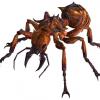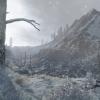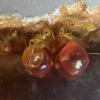We shot a little video of us digging up queens in the Mojave Desert yesterday, so everybody can see exactly what it's like. A strange monsoon-like rainstorm blew through Southern California January 30th, dropping about .3 inches of rain to some parts of the desert. This obviously triggered a couple mating flights some time within the following week. We found both Veromessor pergandei and Myrmecocystus yuma. It was around 80 degrees while we were out there, yet there were almost no ants out at all--just founding chambers. If we saw any activity at all, it was just around the entrance of some of the nests. Even though the rain came through over a week ago, the ground was still very wet. In the middle of the summer, you usually have about three days before the ground dries up, but this early in the year you obviously have much more time. This spot was just off HWY 74, right up the mountain from Palm Desert, California. The elevation there was about 2500 feet, but we did also find a few queens all the way down at the base of the mountains as well, where the elevation was probably around 250 feet.
Anyway, here's the video. We kept the camera running until we dug up two queens, so you can see exactly how long it takes. Short of catching a mating flight when it happens, finding queens in the desert is definitely much easier than anywhere else.

























